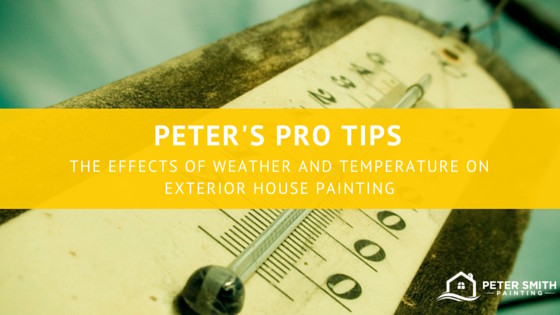Hot or cold, rainy or humid, weather has a significant effect on paint adhesion and the drying time of exterior house painting.
This is the second post in our new series of house painting tips on the Peter Smith Painting blog.
Painting your home when it’s warm outside
If you are painting your home in the heat of the summer, remember that humidity and heat influence the drying time of your paint. This is not an issue as long as there is no rain in the forecast before your paint has a chance to dry.
An important pro-tip: I use double the drying time that the paint manufacturer states when it is hot and humid. This is especially true if you are painting the exterior of your house. When it is very warm inside, the same rule applies.
Don’t paint in the sun when it’s hot outside!
Painting in the heat of the sun is not recommended because the paint will dry to fast.
Although the paint coating should last, you may incur lap marks. Lap marks happen when you paint large areas and the paint dries too quickly, leaving stripes or striations on the surface, ruining the paint’s appearance. Always try and maintain a ‘wet edge’ of paint making sure that the area you paint is not dry, and paint in small sections not large ones.
Painting the exterior of your house when it’s damp, rainy, or wet outside
Want to insure that your exterior paint job will fail? Paint over any wet surface. (We sincerely hope you don’t do this!).
Why shouldn’t you paint over a wet surface? When you paint over an area that is wet, you seal in the moisture and trap it. When the sun hits the surface, it tries to draw the moisture out and causes the paint to lift and not adhere to the surface.
Ever see paint peeling in large sheets? When you see paint peeling in large sheets, it means the monster is trapped and needs a way out, the only way it can get out is to peel.
I’m not sure if the outside of the house is wet, what can I do?
I use a very expensive instrument to measure the moisture on the exterior surface of the house. It’s called a hygrometer or ‘moisture meter’. Since you usually cannot tell by just touching a surface and detecting moisture, this tool removes any doubts.
Painting your house when it’s cold outside
In cold temperatures paint will not dry properly. It will not adhere to the surface
that it is being applied to and will not set correctly.
Numerous paint manufacturers say that their exterior paints are formulated so they can be applied when the outside temperature is in the 30s.I would never paint outside when the temperature is below 40.
Three reasons you shouldn’t paint when it’s cold outside:
- Paint will dry too slowly.
- When the sun sets, if the humidity increases, the paint will stay as wet as when you first applied it.
- At nighttime, if the temperature drops below freezing, the paint will freeze and will not adhere to the surface applied.
This can actually make the paint ‘sag’ or run off a vertical surface, leading to a real mess.
There are many weather and temperature factors that can effect paint, but to be safe, don’t paint when it’s too hot, too cold, or too wet!
Ready for a new look and don’t want to do it yourself?
Peter Smith
Latest posts by Peter Smith (see all)
- Choosing The Right Paint Finish For Your Home - June 20, 2016
- The Effects Of Weather And Temperature On Exterior House Painting - June 10, 2016
- Using A Latex Top Coat For Interior And Exterior House Painting - June 1, 2016

